|
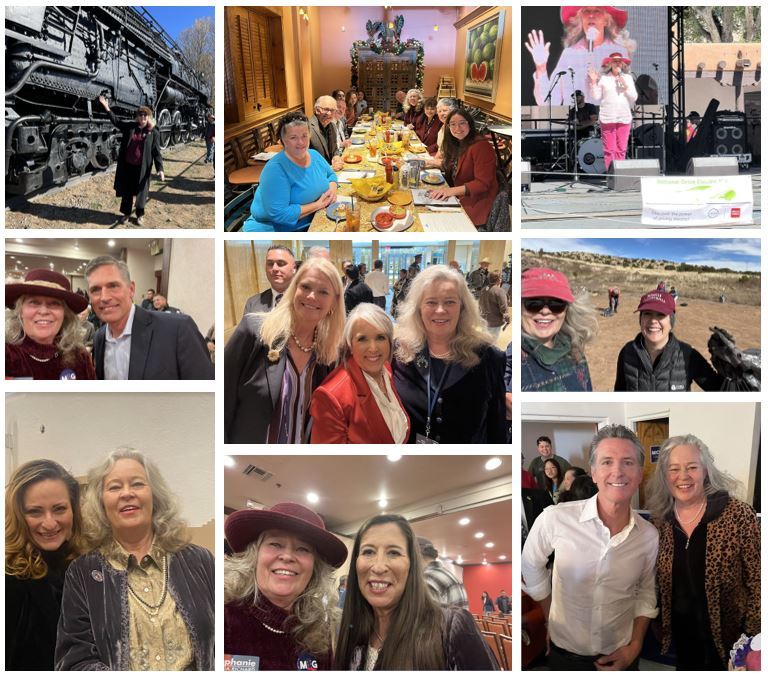 Pictured here are our federal delegation, Senator Heinrich, Representative Teresa Leger Fernandez, and Governor Lujan-Grisham. Senator Nancy Rodriguez, Representative Tara Lujan, and Representative Andrea Romero with the Agua Fria Community. Our city Councilor Renee Villarreal and myself at a Camel Tracks clean-up. Special guest Governor Newsom of California in the lower right.
Dear Constituents and Friends,
Welcome to 2023! We are happy to welcome two new commissioners to the Board of County Commissioners (BCC) from District 1, Justin S. Greene and from District 3, Dr. Camilla Bustamante.
We have been quite busy since my last newsletter with many different projects as you will see below. At our January 10th meeting, I was elected as the Chair of the Board of County Commissioners. I will be serving again on the following committees: Chair of the Coalition for Sustainable Communities New Mexico (CSCNM); President of the Northern Rio Grande National Heritage Area (NRGNHA); Board of Finance; Buckman Direct Diversion (BDD); Extraterritorial Land Use Authority (ELUA); Metropolitan Planning Organization (MPO); Santa Fe Solid Waste Management Agency (SFSWMA); Santa Fe County Investment Committee (SFCIC); North Central New Mexico Economic Development District (NCNMEDD), Alternate; and the REDI Net Board, Alternate. With the National Association of Counties (NACO), I serve (by NACO presidential appointment) as Vice Chair of the Arts and Culture Committee and as the Vice Chair of the Energy subcommittee on Environment Energy and Land Use. I was also elected as Vice Chair of Women of NACO.
Two important projects I have been working on for quite some time both concern the Caja del Rio. There are many people, wildlife groups, and Tribal Nations who want to protect the Caja. The BCC passed a resolution earlier this year, and I will be meeting with the Department of Interior in February while I’m in Washington DC. The other item concerning the Caja is the collaboration with BLM on developing a shooting range in Santa Fe County. (We have a cooperating agency agreement with BLM). We have a very serious problem with “wildcat” shooting out on the Caja, which needs to be protected from contamination and wildfires. Unfortunately, people currently shoot anywhere on BLM land, so we are collaborating to create a safe place for people to shoot while protecting other areas of the Caja. There is a serious issue with lead poisoning for birds and other wildlife from this contamination. People’s homes have been shot at and many people feel unsafe riding their horses, going for walks, and cycling. We need solutions, which is why I am working to create safety out on the Caja.
Below you will also read a letter we wrote and submitted to stop the shipments of Surplus Plutonium through our county and engaged with the Santa Fe National Forest Service asking for presentations on their plans for prescribed burns; I have commented on the Santa Fe Mountain Resiliency Landscape Project again, and I am one of ten objectors to this project with the support of the BCC requesting an Environmental Impact Statement (EIS).
Coffee and Tea under the Trees will resume in May 2023 or as soon as the Farm Stand is open.
One of the proudest achievements I made nationwide is the reauthorization of the National Heritage Areas (NHAs) for an additional 15 years. The new law will create stability for NHAs throughout the country. See below for more details.
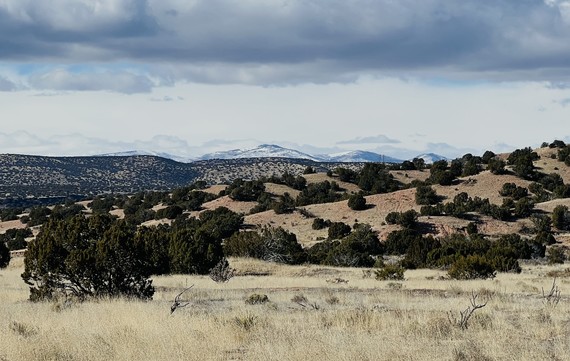 Photo of The Caja del Rio by Anna C. Hansen
|
|
Northern Rio Grande Heritage Area Authorized for an Additional 15 Years
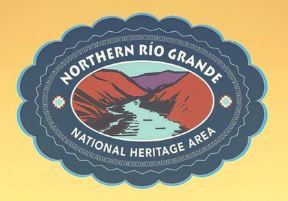
In my second term as President of the Northern Rio Grande National Heritage Area (NRGNHA), which includes the Counties of Rio Arriba, Santa Fe, and Taos, the Eight Northern Pueblos, and the Jicarilla Apache Nation, I want to recognize NACo’s important contribution in helping pass the National Heritage Area Act. I brought forward a resolution at NACo for the past two years to support and reauthorize all NHAs in the US; there are now sixty-two NHAs. The Alliance of National Heritage Areas (ANHA) attempted to include the resolution within the National Defense Authorization Act and the Omnibus Bill, but both efforts were unsuccessful. I consistently emailed NACo, informing them of the need for a letter to leadership. As a result, they sent letters to all House and Senate leadership. I cannot thank Senator Heinrich enough for his dedication and support of the bill. On Tuesday, the evening of December 20th, our bill unanimously passed the Senate, making its way to the House Rules Committee, and eventually to the floor with the vote being 326-95. President Biden signed the bill into law on January 5th.
What does this mean for New Mexico? It means that we as a congressionally created heritage area will receive appropriations from the National Park Service for the next 15 years, and we can invest in our communities to sustain and revitalize cultural heritages. Communities, tribal and local governments, land grant associations, non-profit organizations, youth programs, historical and archaeological societies, and preservations groups are encouraged to apply for grant funding up to $10,000 for programs supporting the NRGNHA’s mission and goals. It is a great gift to the people of the northern New Mexico to secure such a rich heritage area.
The Santa Fe New Mexican published my reaction to the bill signed into law. “NRGNHA President, Santa Fe County Commissioner Anna Hansen, said: ‘It was against all odds and a true Christmas miracle that we got this bill across the finish line. We have all been working on this for over 6-10 years. I want to recognize the role that the National Association of Counties (NACo) played in helping encourage Congress to pass this legislation, the huge effort by all the members of the Alliance of National Heritage Areas, and Senators and Representations on both side of the aisle. New Mexico’s Senator Heinrich played an important role in getting it approved and the bill out of the Energy and Natural Resources Committee in the Senate. Representative Leger Fernandez pushed leadership in the House to get this bill passed in the last days of the year. It was the best present ever to have funding for 15 years to help non-profits who work to preserve our history and culture.’”
This wonderful news was also featured in the Santa Fe New Mexican.
|
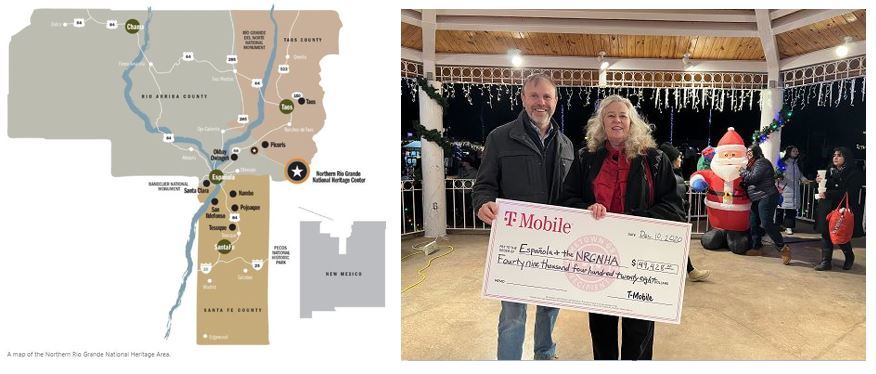 |
Commissioner Hansen and NRGNHA Executive Director Eric Vasquez hold a T-Mobile check for the Española Plaza fountain restoration.
|
|
Santa Fe County Commission Opposes Surplus Plutonium Disposition Program
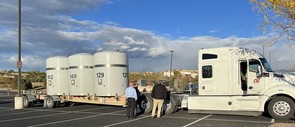
On January 10th, the Board of County Commissioners unanimously approved comments I submitted to the U. S. Department of Energy's National Nuclear Security Administration (NNSA) opposing its proposed Surplus Plutonium Disposition Program, which proposes the transportation of radioactive material to the Los Alamos National Laboratory where it will be diluted then shipped to Savannah River, Georgia for processing in preparation for disposal. Once this stardust is prepared, it will be transported back to New Mexico to be deposited at the DOE's Waste Isolation Pilot Plant in Carlsbad.
A portion of the letter to the NNSA addresses the detrimental impacts this program could have on Santa Fe Community residents and surrounding communities should it be implemented. “Santa Fe County’s approximately 155,000 residents living in close proximity to the transportation corridor needed for the process will be negatively impacted should LANL be selected for any stage of the dilute and dispose process of surplus weapons-grade plutonium. Further, many Santa Fe County residents obtain their drinking water from the Buckman Direct Diversion (BDD) project on the Rio Grande. The BDD is located south of the Otowi Bridge and is subject to contamination from LANL operations that affect Los Alamos Canyon and its tributaries. Increasing flood and storm events in the Los Alamos Canyon watershed are a major source of contaminants to the Rio Grande watershed. In addition, Santa Fe County’s northern boundaries are only a few miles from LANL and could be impacted if harmful contaminants were released in the air or ground from failed operations associated with the proposed actions. The Draft Environmental Impact Statement must take into account the potential contamination effects that the dilute and dispose surplus weapons-grade plutonium approach may have on the air, water, ecological resources, soils, and residents of the surrounding populations, including the citizens of Santa Fe County. It must also consider the use of resources, including electricity, land use for construction of new facilities, as well as impacts to cultural resources, socio-economic, and on-site and off-site transportation, and impacts as a result of waste generation, storage, and disposal on the Pajarito Plateau.”
Entire Letter from Santa Fe County Board of County Commissioners to NNSA
Santa Fe County Commission Opposes Radioactive Material Being Sent to LANL
|
|
|
Legislators' and Commissioners' Town Hall
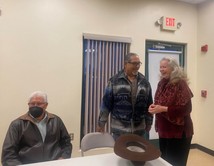
More than 60 concerned community members attended (another 30 via Facebook) the Legislative Town Hall on Wednesday, January 11th, which was organized by Representative Tara Lujan. In attendance was Representatives Chandler and Romero along with Commissioners Hansen and Greene. New Mexico State representatives discussed their legislative priorities for the upcoming 60-day session, including their desire to increase New Mexico's minimum wage from $12 to $16 beginning in January 2024. Chandler believes it is a reasonable bill she's proposing. Read more about the two proposed bills.
|
Commissioner Hansen shared her legislatives priorities for District 2, which includes more money for the Agua Fria Wastewater Project ($10M), Nueva Acequia Multi-family affordable housing and development infrastructure ($10M), plus $5M for upgrades to Camino de Jacobo Public Housing. In addition, the San Ysidro Crossing right of way, Design and Construction ($5M) and 2023 Sustainability Greenhouse Gas Emissions Reduction Plan Project ($3.5M), and many others.
Legislators and Commissioners fielded questions from constituents after their presentations. The attendance was well represented from Districts 1 and 2.
|
|
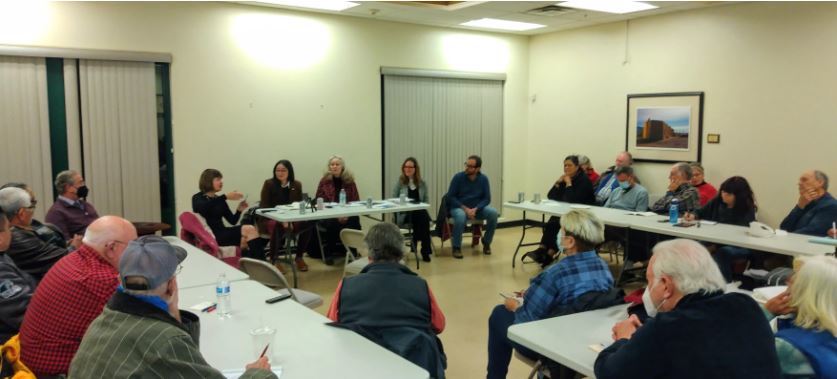 |
Photo by KSFR's Kevin Meerschaert
|
|
News from BLM on Shooting Range Project
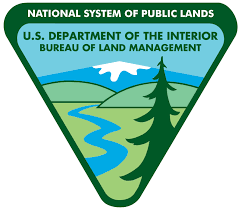
Recreational Shooting Ranges
The BLM and its collaborators are considering developing two target shooting ranges, include one in the Camel Tracks and Buckman-Alamo Creek areas. A suitable location to develop a shooting range in the San Pedro area has not been identified.
The shooting ranges would be developed in areas where safe shooting practices can be accommodated, and where conflicts with other users and neighboring residential areas can be mitigated. Sites would be designed to provide safety, contain lead, reduce noise, and mitigate other potential negative impacts.
Developed ranges could include anywhere between minimally developed infrastructure—such as berms, signage, and delineated parking—to fully developed facilities with a variety of amenities that would accommodate many different users. Each site would have its own set of controls, as necessary, such as direction of shooting, limited hours (e.g., daylight hours only), limited types of firearms, etc.
Remediation of Current Sites
Also under consideration is how to manage the current, undeveloped locations where the conflicts are occurring. Remediation of any environmental degradation or contamination would be necessary, and these vacated shooting areas each have potential to provide for other developed recreational opportunities such as trailheads for non-motorized, single-track trails and off highway vehicle staging areas, for example.
Restriction on Shooting
Shooting would not be allowed within any area developed for other recreational opportunities (per 43 CFR 8365.2-5). Restrictions on shooting will be considered at the current, undeveloped locations where the conflicts are occurring. Restrictions may also be considered as a means of buffering residential areas from shooting. Recreational shooting restrictions would be applied to provide safety, mitigate fire risk, and reduce nuisance and noise.
Recreational Target Shooting Plan for Public Lands
in Santa Fe County and Links to Maps
|
 Proposed Locations and Schedule for Implementation

|
|
Life Link Partnership with Santa Fe County

Commissioner Hansen attended the Life Link Gala on December 2nd where she discussed the partnership established back in 1987. Life Link has also been an enthusiastic partner in the county’s CONNECT network since 2017. Life Link navigators utilize our CONNECT network to provide health-related resources for low-income individuals who are temporarily displaced or experiencing homelessness.
In addition, for the past several years, the Life Link navigator has worked with our County detention center to assist individuals to successfully reintegrate into the community when they leave the jail. The “RISE” program provides individuals with skills and tools to succeed. Of the 65 clients served in this capacity in the last year, only four have returned to the jail, a marked reduction in recidivism. The Life Link’s commitment to find housing, employment and other resources has proved crucial for these individuals who’ve been involved with the criminal justice system. We have been so impressed with these early results that we increased County funding to expand the effort.
The Life Link also graciously agreed to serve as the Fiscal Intermediary for our LEAD-Santa Fe County program, which provides intensive, mobile case management and resources to people with behavioral health challenges who might otherwise be arrested or otherwise drawn back into the criminal justice system.
Since 2018, we have funded the Life Link to the tune of over one million dollars. We look forward to our continued partnership this year and in the years to come.
|
|
|
Santa Fe County Assessor's Office Honors Native American Heritage Month
Laura Kaye Jagles, an enrolled tribal member of Tesuque Pueblo and our D2 Constituent Services Liaison, was interviewed by Assessor staff members about her experience of learning Pueblo traditions from her grandpa, aunts, uncles, Godparents, Godsisters, and cousins. She gives credit to many people who helped shape her knowledge and understanding of the
Tewa Language. This is a community story, not an individual one.
Watch Laura's Interview on YouTube
|
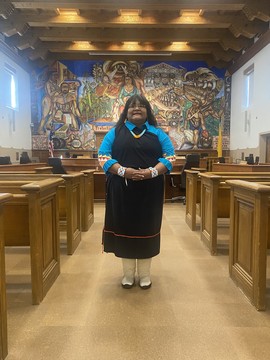 Photo by Olivia Romo, D5 Constituent Services Liaison
|
|
 In case you missed it, I was featured in the following news articles recently:

“I think that is the most important thing that can come out of all of this is that we have some deep sincere engagement and understanding of how people feel and how they see things, education and thinking outside the box,” Commissioner Anna Hansen said.
“There are some immediate things that we know we’re going to be investing in. One of those key things is transparency and coordination,” Duran said.
The national forest presentation included changes made to the project since it was introduced, such as new language in the environmental assessment on environmental justice and climate change.
Still, some commissioners felt too little had been done to address concerns about prescribed burns.
“It’s really rather disappointing to have the [environmental assessment] come out and that there’s basically no changes to it, except for the environmental justice section,” Hansen said. “I mean, climate change might be mentioned, but it doesn’t say how you’re going to mitigate it or how you’re going to work with it.”
|

Commissioner Anna Hansen said she was “very happy” to have passed the measure after wanting such regulation for six years.
“Nothing is perfect,” Hansen said. “There’s always work to be done. What I felt was really important was that we get something in place.”
Hansen was joined by commissioners Anna Hamilton and Hank Hughes. Henry Roybal voted no, and Rudy Garcia abstained.
|
Bishop's Lodge Denied Wastewater
Plant Loan
Commissioner Anna Hansen, who opposed the measure, called it “a really bad deal for the county” and “a misuse of taxpayer money.”
She and Commissioner Hank Hughes voted against it with Commissioners Henry Roybal, Anna Hamilton and Rudy Garcia voting in favor. The county will seek a loan of more than $5 million from the New Mexico Environment Department’s Clean Water State Revolving Loan Fund for the construction of a new wastewater treatment facility at the resort northeast of Santa Fe, which is planning an expansion.
Hansen, an opponent of the deal said: “Why are we giving money to an entity that can get money somewhere else and that has gone bankrupt a number of times?”
If the bond measure passes, the project should go out to bid by March and work would begin in a relatively short time after that, he said.
Santa Fe County Commissioners Hansen, Hughes, and Garcia voted not to proceed with the loan at the November 15th Board of County Commissioners' meeting. Commissioners Hamilton and Roybal voted against the motion.
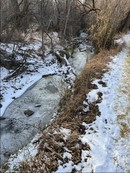
The existing trail was part of a joint effort by the city and county known as the Greenway project.
“The trail has been an incredible investment in people’s health and in the beautification of the county and the city,” county Commissioner Anna Hansen said. “Constituents often tell me how much they enjoy the river trail and inquire as to development of the next phase.”
|
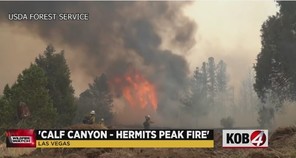
"In recent years, I have been contacted by an increasing number of my constituents who are concerned about the detrimental impacts of large-scale forest fuels treatments on our local Santa Fe National Forest.
Many are concerned about the health impacts of the smoke from frequent prescribed burns that settles into the Santa Fe basin, including the chemical fire accelerants used in the burning process.
In April, two separate escaped prescribed burns caused a 341,000-acre wildfire. It’s been devastating for many traditional rural families. The forest that has supported and uplifted residents for generations may never be the same and will not fully recover for generations. The watershed that once provided clean water to the city of Las Vegas, N.M., has been degraded. This must never happen again. We need an updated approach to managing our forests and protecting our communities from wildfire.
In July, I sponsored, along with Commissioner Anna Hamilton, Resolution 2022-50, urging the U.S. Forest Service to prepare an environmental impact statement for the very large fuels treatment project it is planning for the mountains near Santa Fe — the Santa Fe Mountains Resiliency Landscape Project. We requested that a new risk, costs and benefits analysis be completed, including consideration of the risks to public health, water supplies and the economy. We asked for a public assessment of the use of alternative treatments under accelerating climate change.
I hope other New Mexico elected representatives will join the County Commission in calling for a reevaluation of what is being planned for our forest and communities. In the aftermath of the Hermits Peak/Calf Canyon Fire, we now know how profoundly forest fuels treatments affect all of us.
The Forest Service plans to reinitiate the Santa Fe mountains project decision very soon, after withdrawing it due to the recent fires. The public wants to be heard and requests its input be included as these important decisions are made. We want full transparency and expect the U.S. Department of Agriculture to consider a full range of ecological research before resuming prescribed burns.
At 5:30 p.m. Thursday, my fellow Santa Fe County commissioners and I will be sponsoring a Zoom “listening meeting,” along with conservation organizations WildEarth Guardians and The Forest Advocate. This can be the beginning of an inclusive community dialogue about how we can genuinely protect our forests and support them to be as healthy as possible in our warming and drying climate.
Respected conservation scientist Dominick DellaSala will give a short overview of ecological concerns related to the Santa Fe mountains project and explain why further analysis is necessary. He also will be available throughout the public discussion to answer questions.
Santa Fe National Forest leadership will attend along with other governmental agencies and organizations assisting in the planning and implementation of the project. We are also inviting elected representatives and/or their staff and liaisons to attend. The purpose of the meeting is for you to be heard.
Each person will have two to three minutes to speak, and we hope you will come help us move in a constructive direction to truly foster healthy forests and fire-safe communities. Let’s have a respectful dialogue about a much more holistic paradigm for managing our forests."
Watch a recording of the Listening Session
|
Working Together
(Commissioner Hansen submitted this letter to the editor of the Santa Fe New Mexican, which was published January 7, 2023.)

The recent opinion pieces (“Forests in danger; time to act is now,” My View, Jan. 1, and others) criticizing the recent Living with Wildfire listening session have missed the point. Don’t we want to have a dialogue? The listening session was sponsored by the Santa Fe County Commission along with WildEarth Guardians and The Forest Advocate. The Fireshed coalition was invited to participate and declined. Both Commissioner Anna Hamilton and I attended, and I moderated the meeting.
Dominick DellaSala’s comments presented a conservation alternative and emphasized how important defensible space around your home is. Fire is not the only answer, just the most economical one; except, when it escapes, as we saw with the Hermits Peak/Calf Canyon Fire and other fires. We are not living in the 1880s; we are now living in a climate crisis, and it is 2023. We must adapt to the climate change and the lack of biodiversity we are experiencing now. The forest is not a fireshed. It’s a watershed! Let’s all work together to protect it, making it truly healthy and resilient with genuine restoration.
|
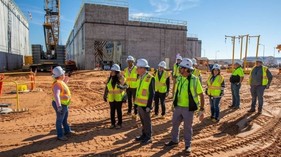 |
|
Environmental Management leaders traveled to Santa Fe to meet with local leaders and regulators. White and Nelson-Jean met with Santa Fe County Commissioner Anna Hansen and State Rep. Christine Chandler. |
|
|
 Protecting Our Wintery Watershed
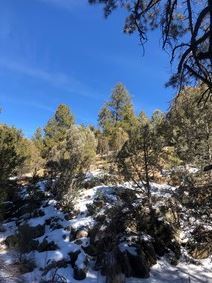
Melting snow can carry pollutants, like de-icer, litter, and pet waste into our waterways. Below are just a few ways you can protect our watershed this winter.
Shovel snow onto vegetated areas, rather than pavement: Snowmelt is a precious source of water in our dry climate. Allow melting snow to soak into the ground by shoveling it onto vegetated areas, rather than piling it on pavement.
Use de-icers sparingly: Melting snow can carry de-icers, like rock salt, into waterways. Always follow package instructions when using de-icers and only use as much as you need to keep your walkways safe. Click here for tips on selecting and applying de-icers.
Pick up after your pet: Make sure to pick up after your pet, even in the winter months, to keep bacteria from pet waste out of our waterways.
|
|
|
|
|
|